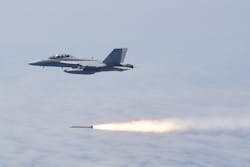Alliant moves to initial production of AARGM-ER radar-killing missile with advanced signal processing
PATUXENT RIVER NAS, Md. – U.S. Navy aerial warfare experts are moving forward with developing a new and advanced radar-killing missile designed to enable U.S. jet fighter-bombers suppress enemy air defenses preceding bomber attacks.
Officials of the Naval Air Systems Command at Patuxent River Naval Air Station, Md., announced a $41.2 million contract Tuesday to Alliant Techsystems Operations LLC, a wholly-owned subsidiary of Northrop Grumman Defense Systems Inc. in Northridge, Calif., for low-rate initial production lot one of the AGM-88G Advanced Anti-Radiation Guided Missile - Extended Range (AARGM-ER).
The AARGM-ER is an advanced and extended-range version of the High-Speed Anti-Radiation Missile (HARM). It is a new variant of the AGM-88E missile that equips Navy carrier-based fighter-bombers and electronic warfare jets. HARM was a replacement for the AGM-45 Shrike anti-radiation missile, which was in service from 1965 to 1992.
Low-rate initial production happens when engineering and manufacturing development is finished and the designer starts building a small quantity of missiles to establish an initial production base from which production rates gradually increase.
This contract calls for Alliant Techsystems to build 22 AARGM-ER missiles -- 16 all-up rounds and six captive air training missiles. The company started AARGM-ER engineering and manufacturing development in early 2019.
The AARGM offers advanced signal processing and improved frequency coverage, detection range, and field of view, compared to earlier versions of the HARM system. It has time-critical standoff strike with supersonic GPS/INS point-to-point or point-to-millimeter-wave-terminal guidance.
The contract also calls for Alliant Techsystems to provide four common munitions BIT reprogramming equipment plus interface devices, initial spares, supplies, and support.
AARGM is a supersonic, medium-range, air-launched tactical missile for U.S. and allied strike aircraft. The AARGM-ER missile features several upgrades to the AGM-88E that focus on extending the weapon's operational range and survivability.
The AARGM-ER replaces the missile's rocket motor and tail to increase its range, while keeping the sensors and electronics of the AARGM-88E, which are being upgraded in a separate project. The new missile is especially well suited for the F/A-18E/F Super Hornet jet fighter-bomber and EA-18G Growler electronic warfare jet.
Related: The coming revolution in sensor and signal processing
The Navy F-35C carrier-based stealthy joint strike fighter also can carry the AARGM-ER inside its internal weapons bay. Northrop Grumman Innovation Systems predecessor Orbital ATK began developing the AARGM-ER in January 2018.
The AARGM-ER missile is scheduled to achieve initial operating capability (IOC) and start being fielded to Navy squadrons in 2023.
AARGM provides the U.S. Navy, U.S. Marine Corps, and Italian air force with a weapon system for engaging and destroying enemy air defenses and time-critical, mobile targets. The AARGM also has precise Global Positioning System (GPS)/inertial navigation system (INS) guidance and network-centric connectivity.
Related: Raytheon to upgrade radar signal processing for missile-defense system in Thule, Greenland
It also has missile impact zone control to prevent collateral damage through tightly coupled, digital terrain elevation database-aided GPS/INS, as well as counter-emitter shutdown through active millimeter-wave-radar terminal guidance.
In early 2018 Orbital ATK engineers started upgrading the sensors and embedded computing components of the AGM-88E to help mitigate existing missile cost and production issues. This project involved building the executive processor circuit card assembly for the missile's advanced digital anti-radiation homing sensor and its millimeter wave radar terminal seeker.
These upgrades were to support Naval Air Systems Command's Direct and Time Sensitive Strike program office. Upgrades were to mitigate cost and production issues, as well as incorporate hardware for future expansion.
On this AARGM-ER EMD contract Alliant Techsystems will do the work in Northridge and Ridgecrest, Calif.; and Rocket Center, W.Va., and should be finished by March 2024. For more information contact Northrop Grumman online at www.northropgrumman.com, or Naval Air Systems Command at www.navair.navy.mil.

John Keller | Editor-in-Chief
John Keller is the Editor-in-Chief, Military & Aerospace Electronics Magazine--provides extensive coverage and analysis of enabling electronics and optoelectronic technologies in military, space and commercial aviation applications. John has been a member of the Military & Aerospace Electronics staff since 1989 and chief editor since 1995.

